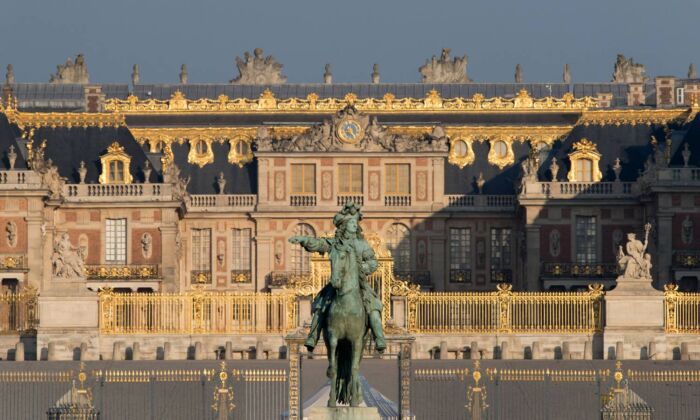Texas Governor Declares Disaster After Brain-Eating Amoeba Found in City’s Water
From 1682 until the French Revolution of 1789, successive kings of France lived, worked, and held court in the most opulent of accommodations: the Palace of Versailles.
King Louis XIV began the tradition after he expanded his father’s hilltop château, a luxurious rural retreat. Over a period of 50 years, the palace became the largest and most influential château in Europe and a source of great artistic invention in architecture, music, theater, and the decorative arts.
 King Louis XIV chose the sun as his emblem; he was known as the Sun King. (Thomas Garnier/Château de Versailles)
King Louis XIV chose the sun as his emblem; he was known as the Sun King. (Thomas Garnier/Château de Versailles)Many of the nation’s greatest architects designed and built the Palace of Versailles. Architect Louis Le Vau, an early adopter of French Baroque architecture, added two symmetrical wings onto the original château, giving the palace its distinctive U-shaped design. Each wing, on either side of the forecourt, contained separate grand apartments for the king and queen. The king’s bedchamber was moved to the center of the U-shaped buildings in 1701.
 A view through the doorways in the king’s apartments. (Thomas Garnier/Château de Versailles)
A view through the doorways in the king’s apartments. (Thomas Garnier/Château de Versailles) The Room of Abundance, in the king’s apartments, served as a refreshment room where coffee and wine were served on a sideboard. (Thomas Garnier/Château de Versailles)
The Room of Abundance, in the king’s apartments, served as a refreshment room where coffee and wine were served on a sideboard. (Thomas Garnier/Château de Versailles) A sculpture of Marie-Antoinette by Félix Lecomte, 1783. (Thomas Garnier/Château de Versailles)
A sculpture of Marie-Antoinette by Félix Lecomte, 1783. (Thomas Garnier/Château de Versailles) The Queen’s Bedchamber. (Thomas Garnier/Château de Versailles)
The Queen’s Bedchamber. (Thomas Garnier/Château de Versailles) Detail of a tapestry in the queen’s apartments. (Thomas Garnier/Château de Versailles)
Detail of a tapestry in the queen’s apartments. (Thomas Garnier/Château de Versailles)Architect Jules Hardouin-Mansart, whom many scholars credit with representing the best of French Baroque architects, created the famed Hall of Mirrors and extended the palace estate further with sumptuous additions such as the Royal Chapel and the Grand Trianon. Louis XIV closely oversaw the building of the Grand Trianon, which he commissioned as a retreat from court life. Hardouin-Mansart described it as “a little palace of pink marble and porphyry [igneous rock], with marvelous gardens.”
 The Hall of Mirrors served as a place for meeting and waiting. The Treaty of Versailles, which ended World War I, was signed here on June 28, 1919. (Thomas Garnier/Château de Versailles)
The Hall of Mirrors served as a place for meeting and waiting. The Treaty of Versailles, which ended World War I, was signed here on June 28, 1919. (Thomas Garnier/Château de Versailles)Louis XIV’s great-grandson, King Louis XV, commissioned architect Ange-Jacques Gabriel to create the Royal Opera at Versailles, realizing in 1770 his great-grandfather’s idea.
In 1833, King Louis-Philippe afforded the palace an illustrious new role as the Museum of the History of France, which was inaugurated in 1837 and dedicated “to all the glories of France.”
 A statue representing the Rhône river. (Thomas Garnier/Château de Versailles)
A statue representing the Rhône river. (Thomas Garnier/Château de Versailles) The Parterre of the Orangerie. (Thomas Garnier/Château de Versailles)
The Parterre of the Orangerie. (Thomas Garnier/Château de Versailles)Focus News: Versailles: A Palace Fit for the Sun King
Packing Supreme Court an ‘Empty Threat,’ Unlikely to Happen: Former FEC Member
